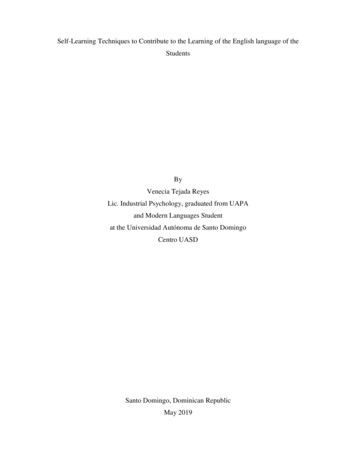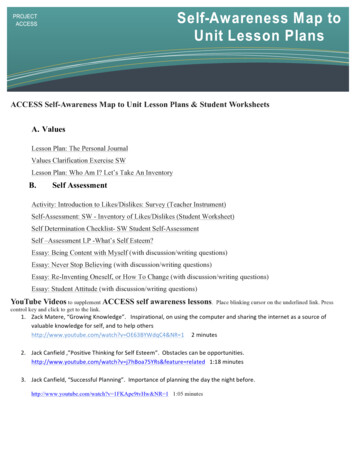
Transcription
Self-Learning Techniques to Contribute to the Learning of the English language of theStudentsByVenecia Tejada ReyesLic. Industrial Psychology, graduated from UAPAand Modern Languages Studentat the Universidad Autónoma de Santo DomingoCentro UASDSanto Domingo, Dominican RepublicMay 2019
IndexAbstract . IIntroduction. IIChapter I: Introductory Part of the Investigation. 1Statement of the Problem. 1Justification . 2Objective . 2General Objective . 2Specific Objectives . 21)How self-learning should be to achieve a transformation in students. . 32)What are the self-learning techniques and what is your contribution to learning theEnglish language. . 33)How students acquire self-learning techniques. . 34)What are the advantages and disadvantages of using self-learning techniques?. 3Delimitation . 3Geographical Context and Historical Backgrounds . 3Antecedents. 6Definition of Terms . 7Acquisition of a Second Language . 7Learning . 7Self-learning . 7Chapter II: Review of the Literature . 8Acquisition of a Second Language . 8Self-Learning . 11The Study Techniques and their Contribution to the Learning English Language. . 12How do Students Acquire Learning Techniques? . 15Advantages of Learning Techniques: . 16Different Technique . 16Technique: Music in English . 16Technique Lyrics . 16Technique the Mirror . 17Technique the Cinema at Home . 17Technique Reading . 17
Technique Volunteering. 18Technique Telephone . 18Technique Spanglish . 18Technique Interviews . 18Chapter III: Methodology and Data Collection . 19Method . 19Instruments. . 19Technique . 19Design of the investigation . 19Population. . 20Schedule (Schedule) of Activities . 20Chapter IV: The Results and Data Analysis . 21Expect Results . 21Conclusion . 22ReferencesAttached
AbstractLearning techniques or study strategies are different perspectives applied to learningin general. Apparently, they are critical to the success of students in school. There arevarieties of learning techniques, which can focus on the process of organizing, taking andretaining new information, or passing chnicas-de-estudio/)The conceptions that sustain the learning techniques to contribute to the students'learning of a foreign language are based on the active and creative appropriation of a newknowledge through a constant self-improvement of their autonomy and self-determination,in close connection with the ability to analysis in the teaching-learning of the Englishlanguage to facilitate the resolution of problems, based on their needs and interests. It isimportant to work with knowledge, that is, the formation and development of practical andintellectual skills, of great responsibility in the task of education and in their learning toachieve an active and creative appropriation of new knowledge to favor their selfperfecting, in order to apply them in solving problems to transform reality. The objective ofthis research is to offer a theoretical and methodological foundation of the self-learningtechniques to contribute to the learning of the English language of the students of theElpidio Brito Cueto High School, belonging to the Educational District 11-04. For thevalidation, research methods and techniques were applied that allowed to verify thepertinence of the learning techniques in order to contribute to the learning in the students ofthe primary level and secondary.Key words: technique, self-learning, language acquisition.I
IntroductionDuring the last decade, the teaching of a foreign language at an early age has beenimplemented in many schools and numerous studies of language acquisition havecontributed to this expansion. The acquisition studies suggest that when students learn asecond language at an early age, they develop their grammatical systems in a non-consciousand natural way, by coming into contact with the linguistic data of the language in question.(M. Teresa Fleta Guillén, Meeting 16, 2006, pp.51-62) According to the pedagogicalapproach, learning is considered as a process of relatively permanent modification of thestudent's mode of action, which models and remodels his experience according to itsadaptation to the contexts in which the environment with which it relates is specified eitherat any level of study. (Pinker, 1995: 18).English language learning emphasizes the student's need to master communicationin this language, because it is difficult for them to study, since not everyone manages to usea correct technique to learn content, less to have a fluent communication, they needdedication and study to overcome difficulties in their training. Education in today's worldneeds to be increasingly efficient. (Kuhl, 2000: 54).However, it is worrisome to see thedeficiency presented by students at both the primary and secondary levels of the highschool Professor Elpidio Brito Cueto, when facing the reality of their learning. This iswhere the problem of this research lies, since, although the individual and intrinsiccharacter of school learning is undeniable, it also depends on the mediation of the teacher,his classmates and the cultural context in which he or she develops. The students of thiseducational center often have difficulties to organize the study and their duties, and showan erroneous concept of what it is to study, sometimes they do not achieve academicallyII
satisfactory results, and this is because they do not have organization or do not knowtechniques and resources that can help them improve their academic performance.The problematic one raised, in opinion of the authors, is generalized in the primaryand secondary education, since still subsist in the educative units traits of the traditionaleducation where the student is a passive receiver of information, incapable to activate hislogical knowledge of the thought and produce active learning. Developing skills to learnindependently means having a feeling of personal competence, which results in motivation,self-confidence, study techniques, will allow the development of intelligence, autonomy,ability to analyze and solve problems improving, sequentially, his academic performance,becoming protagonist and responsible for the new knowledge. The learning of English mustbe aimed at generating new knowledge, which enhances the possibilities of the future of thestudents of our country; that prepares them to face their educational reality, interpret it andtransform it according to development.Studies on self-learning techniques in English language learning provide evidence tospecialists on how acquisition processes are carried out and serve to better teach theselanguages at school. This research presents practical ideas aimed at facilitating Englishlearning techniques in primary and secondary, keeping in mind the needs of the learnersduring the early stages of learning and taking into account factors such as the learningcontext or exposure time to the linguistic data of the environment.The research proposal is structured in four parts: Chapter I; Introductory part of theinvestigation; Chapter 2: Theoretical framework of the investigation; Chapter 3:Methodology; Chapter 4: Analysis of the results, conclusions and bibliographicalreferences.III
1Chapter I: Introductory Part of the InvestigationStatement of the ProblemIn the field of education, there is a general agreement to define the self-learning thatcould normally be better conceived if the appropriate techniques are used for the adequatelearning of a second language with an excellent result in the student's learning.This happens because this problem has been detected in the students of theelementary and secondary education institution of the teacher Elpidio Brito Cueto of theSan Felipe Province of Puerto Plata, they have not been able to have a visible development,mainly in the subjects of English, and they have been locked in an arbitrary system ofstudy.The lack of a good use of the proper techniques of self-learning to learn a language,make them a bad practice of memorization, through the repetition of the knowledgehandled by the teacher, which makes that the previous knowledge that had the student,preventing creativity and good preparation of appropriate self-learning techniques.The lack of motivation is also an important factor since the professors fail to makethe student identify with the subject of English; the student thinks that everything necessarymust be the lyceum and that he does not need to use self-learning techniques for his greaterdevelopment.So, after considering the above, we formulate the following research problem,which are the self-learning techniques that contribute to the learning of the Englishlanguage of the elementary and middle school students of the Elpidio Benito Cueto highschool, Education District 11-04?
2JustificationThe research group has selected this problem, which is of great importance since themain drawback with which the students are in this school has been the misuse of selflearning techniques so that they do not know how to implement it well. I had trouble tobetter understand the oral expression, the teaching of grammar, writing and other Englishlanguage skills that is totally common and manageable, but that the student does not knowhow to face it.Therefore, our purpose is to show the students the great capacity with which theycan count on to learn a language.The research group has the necessary knowledge to address this research, and wehave the authorization of the educational establishment to investigate, which have given usall the necessary permits, for the realization of the same, reason for which we areconducting the study for the benefit of the institution.ObjectiveGeneral ObjectiveTo Analyze the self-learning techniques to contribute to the learning of the Englishlanguage of the students of basic and average of the high school professor Elpidio BritoCueto, of the Educational District 11-04.Specific Objectives1. To define the concepts of second language.2. To know how to achieve a transformation in the students.
33. To analyze the technique self-learning and what is your contribution to learnEnglish.4. To investigate how the students acquire the technique of self-learning.5. To specify the advantages and disadvantages of using self-learning techniques.To respond to the research objectives we ask the following questions:Research Questions1) How self-learning should be to achieve a transformation in students.2) What are the self-learning techniques and what is your contribution to learning theEnglish language.3) How students acquire self-learning techniques.4) What are the advantages and disadvantages of using self-learning techniques?DelimitationThe following research study was defined in the elementary and middle school ofthe high school Professor Elpidio Cueto, belonging to the Educational District 11-04, of theprovince of San Felipe, Puerto Plata, Dominican Republic. The problem under study isabout Self-Learning Techniques to Contribute to the Learning of the English language ofthe Students. It was conducted during the August-December period of the current schoolyear 2018-2019.Geographical Context and Historical Backgrounds
4Characterization of the center. Elpidio Brito Cueto High School is located in frontof the water tank, west part of the Ama Project, of the Municipality of Luperón, province ofPuerto Plata, belonging to Education District 04 of Regional 11, in the rural zone. It is nextto the Juan Bentz Basic Education Center and Adults.The Center was founded by the government, under the presidential mandate of Ing.Hipólito Mejia on October 19, 2000. Start imparting the first and second grades with theLicda teachers. Maritza Dominguez and the Licdo. Elpidio Brito Cueto, coordinated by theLicda. Maritza Dominguez. It was given the name of Juan Bentz in honor of Mr. JuanBentz who was the owner of all these lands, being stripped by former President RafaelLeónidas Trujillo, had to live on the edge of the land full of misery and calamity.The center is located on flat land with an approximate area of 3145 m2; there are thebasic elements for the proper functioning of the center such as: cistern, sports court, schoolgarden and adjacent bathrooms. The school environment is characterized by the vegetationof fruit trees among them: oranges, sour lemons, avocados, cherry, guava, mango, coconut,trees and ornamental flowers that constitute the beautification of the environment. In theyear 2001, the Third and Fourth grades are completed with the Licda teachers.Maria de Jesús Ureña and the Licda. Isabel Peralta. The Center is made up of adirector, the faculty, the school board, the students, the course and student councils, themanagement team, the parent committee, APMAE, the parents' school, a secretary and thesupport staff. In addition, the center at the present time is participating in all the innovationsthat are being applied in schools within the ten-year plan to achieve a better quality ofeducation and obtain the effective school to face the new millennium. . (Operationalmanual of the high school Elpidio Brito Cueto, 2018).
5In the school year 2018-2019 through the ordinance of 1-2014 the center goes to themodality of extended school day and according to the operating manual of educationalcenter, in the organization of the center it passes to category III, in addition in December2018 they begin the change of name process where the community in general approves thatsaid center will have the name of Professor Elpidio Brito Cueto in January 2019 is changedofficially.Identity of the center. The Center is a public institution that responds to needs,providing for the production of young people who join the productive process of theirfamilies, themselves and society. It operates from 8:00 AM until 4:00 PM in ExtendedSchool Day.Values promoted by our center. In the center, the religious beliefs professed byparents, students and teachers are respected. The ideological pluralism of all actors in theprocess is also respected, provided that they do not contradict the principles established inthe constitution of the Dominican Republic, the law 66 97 of education and good customs.Principle and purposes of Dominican education. Education is promoted thatcontributes to cognitive development, social promotion, the development of anunderstanding spirit, cultivating the emotional, physical and spiritual faculties thatcontribute to an integral education, maintaining the discipline and quality of education,forming good citizens, useful to the homeland, to themselves and their families, fostering adynamic, creative and participatory process, guiding students in a flexible and efficientmanner, with responsibility, seeking to implement the constructivist methodology andmeaningful learning. This completely protected with metal gates, has 10 classrooms, anadministrative office and manager, cafeteria, sports court, recreation area, two bathrooms
6for students, a bathroom for teachers. (Operational manual of the high school Elpidio BritoCueto, 2018).The school structure is arranged in 4 pavilions with the following distribution:1. First pavilion with three classrooms, a bathroom and the cubicle of the address2. Second pavilion with three classrooms one destined for the library3. Third pavilion with 4 classroomsFourth pavilion with a classroom, kitchen area and multipurpose room. (Operationalmanual of the high school Elpidio Brito Cueto, 2018)AntecedentsIn the research conducted, it was found that the investigative works that are mostrelated to the theme of the present project are:Institutional InvestigationsMay Pedraza, Jhon Rodríguez and Paola Cristancho, in their undergraduate thesis(2011), of the Free University under the title Self-Learning Technique through theapplication of workshops in English to second grade students of the middle level of thedistrict educational institution Domingo Faustino Sarmiento, arriving at the following: thisthesis mentions the importance of the use of different self-learning techniques and thepreparation of students in the classroom. English must motivate to learn and to knowanother culture. In the same way, the basic linguistic competences and the diversecapacities of the human being must be put into practice. For this, workshops can be used toreach significant learning in relation to other areas of knowledge such as English.
7According to Carmen Patricia Cánovas Corral (2011), in their undergraduate thesisof the Free Autonomous University of Mexico. in the title of the thesis: Learningvocabulary in the classroom Techniques and Strategy In order to identify the self-learningtechniques used by students, he concludes that it is important to use the different selflearning techniques, in the teaching-learning process, because students get richer with thesetechniques and their ideas flow better.Definition of TermsAccording to some authors it provides the following glossary:Acquisition of a Second LanguageSeries of factors that will strengthen or weaken it. One of these factors is thepersonality factor that is believed to be an influential factor in learning L2. (Bailey et al.,2000).LearningAccording to Carlos Manuel Alvarez de Zayas (1998), in his work Pedagogy asScience says "Learning is the activity that the student develops to learn, to assimilate thesubject of study, on the other hand the teaching is referred to the activity that the teacherperforms.Self-LearningThe term self-learning strictly refers to learning oneself in a reflexive act, in thesame way that the automobile is the one that moves likewise, and self-learning carried outby oneself, it is more appropriate to use the term autonomous learning. (Zaya, 1998)
8Chapter II: Review of the LiteratureAcquisition of a Second LanguageAccording to different studies, the acquisition of an L2 is influenced by a series offactors that will strengthen or weaken it. One of these factors is the personality factor that isbelieved to be an influential factor in learning L2. Before delving deeper into the discussionof personality factors. (Bailey et al., 2000).Burt, Dulay and Krashen (1982). Technically, the term "acquisition" refers tocollecting an L2 through exposure and the term "learning", on the other hand, refers to theconscious study of an L2. However, in this document, both terms are used interchangeably,since the main focus would be on the role of individual personality factors in the SLAprocess from an Islamic perspective and the process involved will be learning throughexposure and conscious learning.Burt, Dulay and Krashen (1982, as cited in Mohideen, 2001) used the term "secondlanguage" to refer to foreign and host languages other than the mother tongue or mothertongue. In this document, the focus of the SLA is placed on the use of the English language,as it often has the official status of a strong L2. In general, learning an L2 is not a set ofeasy steps, since young children acquire their first language or their mother tongue. It israther a long and complex task in which a student has to struggle to reach beyond theconfines of his first language into a new language. It is possible that some learners have towork hard to acquire the knowledge of an L2, while others can acquire great skill withoutmany problems and others are governed by certain needs and interests that influence howthey actually perform. Many researchers would now accept that it is not only important toknow other aspects of the foreign language, but also the fact that different learners in
9different situations learn an L2 in different ways in which these differences may be theresult of the indirect influence of the factors of personality (Bailey et al, 2000).In constructivist or in-depth learning teaching approaches, the student is not thepassive receiver of the information but has the role of accessing, processing and structuringthe information actively. Teachers that have this perspective are expected to set their activelearning perspectives more to work, to support cooperation among students, and toencourage students more on undertaking the learning responsibility (Schunk, 2015).In the meantime, students that have this perspective can be said to have importantadvantages like solving unstructured problems, developing a positive attitude towardslearning, being successful academically (Cano, 2005; Schunk, 2015).Teachers and students who have this perspective are expected to adopt moderneducation philosophies more (Ornstein, 2015). However, in traditional or surface learningteaching approach teacher is the source of information and the student is the passiveinformation receiver. In this approach teacher centered strategies are more likely to be setto work. Furthermore, we can say that students that have this perception are moreincompetent in solving unstructured problems, developing a positive attitude towardslearning, and with regards to academic success (Cano, 2005; Schunk, 2015). Teachers andstudents that have traditional or surface learning teaching approach perspective areexpected to adopt traditional education philosophies (Ornstein, 2015).How Should Learning be to Achieve a Transformation in Students?Regarding how learning should be to achieve a true transformation in the students,have been pronounced specialists like (Zilberstein, J. 1996, 2000,2002), (Lopez Hurtado, J.2002), F. González Rey (1995), (Rico Montero, P. 1996, 2002, 2004 ), (D. Castellanos S.
102003), among others, which highlight the position of students in learning and emphasize thecorrect direction by the teacher. Similarly, they refer to the need to stimulate the developerlearning as an important condition for the formation and development of the students.The difficulties in learning that are common in the different levels of education,which causes that the students who enter the Universities, present gaps and little domain ofthe contents that should have expired in the previous levels, what is the result, largely fromthe application of the methods of traditional teaching on the part of teachers and the littleinvolvement of students in learning.From the experience of the authors, the instruments that are applied for thediagnosis of the professionals in training of the career of Clinical Laboratory, it waspossible to verify that the students present difficulties in the learning of English, which ismanifests in:1. Insufficient training of intellectual abilities from the learning the foreignlanguage.2. Little motivation for the study activity in English and other subjects.3. Little personal training of autonomy and determination with the learningprocesses.4. Limited knowledge of study techniques that allow Develop creativity.The difficulties mentioned have their origin, therefore, in the insufficiencies in thestudy during the learning of English by the professionals in formation. Therefore, it isproposed to implement study techniques in English to contribute to the achievement of adeveloper learning by the students.
11Self-LearningCarlos Manuel Alvarez de Zayas (1998), in his work Pedagogy as Science says"Learning is the activity that the student develops to learn, to assimilate the subject ofstudy, on the other hand the teaching is referred to the activity that the teacher performsHowever, in the traditional educational process the student becomes the object of theprocess so that the most important thing is not manifested, that this is inserted into theprocess as a subject of their own learning ". (Page 1)According to the research group, self-learning is the way to acquire new knowledgethrough self-effort, with the individual assessment of information and processes that eachperson considers appropriate for their learning. This is composed of a systematizationcontributed by the one who learns for the development his capacity to use in the daily life,the new knowledge, in this context it is spoken of an integral learning that is to say: usefulfor the life.The term self-learning strictly refers to learning oneself in a reflexive act, in thesame way that the automobile is the one that moves likewise, and self-learning carried outby oneself, it is more appropriate to use the term autonomous learning. It consists oflearning by means of the individual search of information and the individual realization ofpractices or experiments. A person who learns by itself is called self-taught (self-taught isthe feminine or plural-neutral form). Self-learning is something that human beings,mammals and other animals possess in themselves and show themselves when they play,sometimes play is not present, has the main function of learning new skills or improvingthose already possessed.
12The Study Techniques and their Contribution to the Learning English Language.In the middle of the daily life of the school, students must be educated, with the bestvalues and the most advanced advances in science; you have to help them manage theirforces with security and independence, based on the learning activity of the student intraining defines independent work as a means for including them in independent cognitiveactivity, as a means of their logical and psychological organization. This definitionhighlights an important aspect is to declare the purpose of independent work, the inclusionof the professional in training in cognitive activity and develop the cognitive independenceof the student in training.Independent work is also focused as a method, procedure, form of organization andeven, as a system of didactic measures directed to:a) The improvement of knowledge and its development.b) The consolidation of knowledge.c) Practical skills training.d) The formation of the tendency to independent search for new knowledge.A system of independent work tasks with these characteristics should help theprofessional in training to progressively assume professional action modes in thecommitment, self-awareness, independence and creativity are evident.It was assumed that the system of independent work tasks consists in carrying outconscious, mental (or intellectual) and practical actions, aimed at achieving a higher levelof cognitive independence and with it the real possibility of an application creative of th
Learning techniques or study strategies are different perspectives applied to learning in general. Apparently, they are critical to the success of students in school. There are varieties of learning techniques, which can focus on the process of organizing










